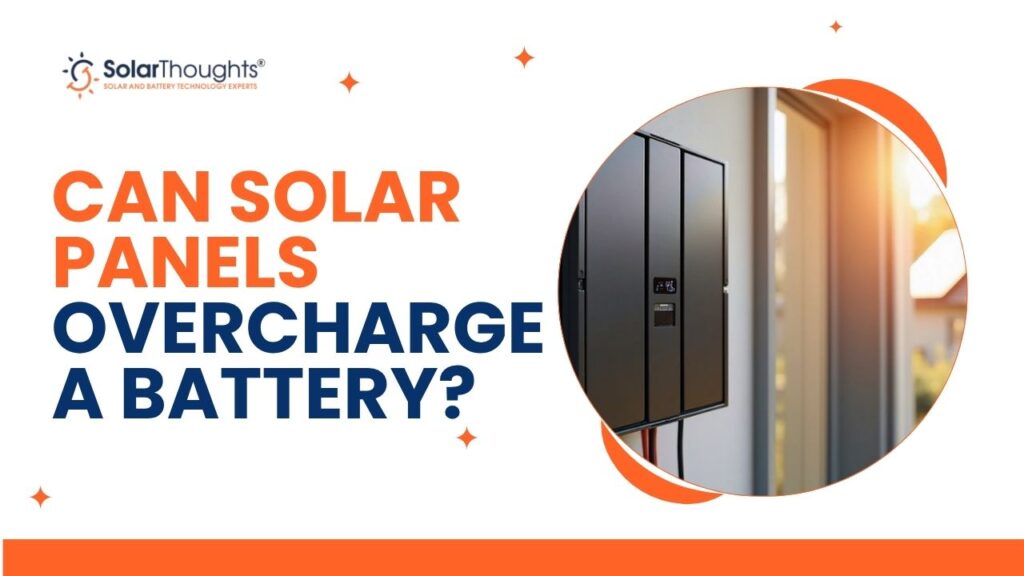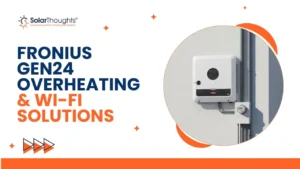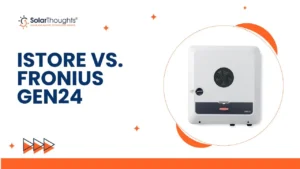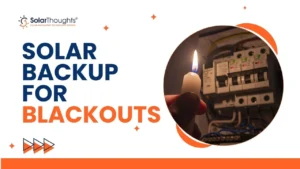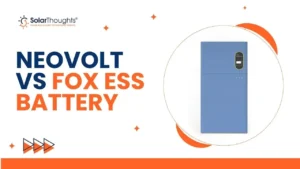Solar panels can overcharge your batteries if you don’t have proper safeguards. Your batteries face dangerous conditions when solar panels generate more electricity than needed. Battery overcharging becomes a real concern, especially when you have different battery technologies. Lead acid batteries start gassing when overcharged. Lithium-ion batteries can develop unstable internal conditions that increase pressure and create potentially dangerous thermal runaway. Most 12V photovoltaic panels generate 16 to 20 volts, while deep cycle batteries need only 14 to 15 volts to reach full charge.
Table of Contents
ToggleThe good news is that modern solar systems come with built-in protection against overcharging. Your charge controller plays a significant role to ensure your battery gets the right charge level and stays protected from damage. You need to understand how these systems work and follow manufacturer guidelines to keep your batteries healthy and safe. This piece explains what happens when batteries reach full capacity, shows you signs of overcharging, and helps protect your solar battery investment from damage.
Can You Overcharge a Battery with Solar Panels?
Yes, solar panels can overcharge batteries if your system doesn’t have proper regulation components. This is a big deal as it means that even with today’s advanced solar technology, system owners who don’t understand their equipment’s functions face real risks.
Why Overcharging is Still Possible in Modern Systems
Modern technology has come a long way, yet battery overcharging in solar systems remains a concern. We noticed batteries receive more energy than they can safely store. Your solar panels’ higher charging voltage pumps excessive amp-hours into the battery.
Your batteries might overcharge because of:
- Your battery management system (BMS) malfunctions or you configured the system incorrectly
- You set wrong manual voltage settings on charge controllers (like setting a 12V battery to charge at 15V instead of 14.4V)
- Your system components don’t match and solar panel output is nowhere near battery capacity
- The controllers can’t adjust fast enough to handle sudden voltage spikes during peak sunlight
Different controller types protect your batteries differently. PWM (pulse width modulation) controllers react slowly to light changes and batteries might overcharge at the end of their charging cycle. MPPT (maximum power point tracking) controllers handle changing conditions better.
What Happens to Solar Power When Batteries Are Full
Your system needs to deal with excess energy once batteries reach full capacity. Here’s how it works:
Most modern solar systems use charge controllers that stop electricity flow the moment batteries signal they’re full. These controllers work like gatekeepers and make sure each battery gets just the right amount of charge.
Your system can send excess power back through net metering if you’re connected to the utility grid. This lets you earn credits by contributing renewable energy to your community grid.
Off-grid setups handle excess power differently. Your solar charge controller can:
- Send extra power back to the panels, which wastes potential energy
- Move it to a designated dump load
- Switch to “float charge” mode that keeps battery levels steady without overcharging
The BMS tells your charge controller to stop charging at the time batteries hit 100% state of charge (SoC). This happens automatically without your intervention.
Modern lithium batteries come with extra protection. Their built-in computerized management systems keep things running safely under normal conditions. All the same, you need the right charge controller setup to keep your system healthy and performing well long-term.
What Happens When a Battery is Overcharged
Overcharging batteries damages them beyond just reducing their capacity. Let’s get into what happens inside a battery when it receives more charge than it can handle safely.
Reduced Battery Lifespan and Capacity
Overcharging cuts a battery’s operational life by speeding up internal deterioration. Research shows that batteries overcharged for 800 cycles see their state of health (SOH) drop to just 67.52%. This represents a decay rate 156.25% higher than normal charging cycles. High-temperature cycling makes things even worse, with SOH decay rates jumping by 419.88% after only 400 cycles.
Several factors cause this quick breakdown:
- Heat speeds up wear on internal components
- The electrolyte evaporates or breaks down, which reduces capacity
- Damaged electrodes can’t store energy efficiently
An overcharged battery’s internal resistance becomes 5-7 times higher than a properly charged one. This increased resistance makes the battery deliver power less efficiently, causing poor performance well before it fails completely.
Thermal Effects and Fire Hazards
Heat generation poses the biggest danger when overcharging batteries. Batteries work best within specific temperature ranges (usually 0°C to 40°C). A battery converts excess energy to heat when overcharged, creating a dangerous cycle:
- The charging current heats up the battery
- Higher temperatures lower internal resistance
- Lower resistance lets more current flow
- More current creates more heat
This feedback loop creates what experts call “thermal runaway” – heat builds up faster than it can escape. Battery temperatures can quickly shoot past 50°C once thermal runaway starts, leading to dangerous situations.
Australia alone has seen nine incidents of overcharged solar batteries causing property damage and injuries since October 2019. Australian consumer protection agencies have logged 231 safety reports related to lithium-ion battery problems over five years.
Internal Pressure and Gas Emission in Lithium Batteries
Overcharging creates unstable conditions that build up gas and pressure inside batteries. Lithium-ion batteries face specific issues:
- The electrolyte breaks down and releases toxic, flammable gasses
- Rising pressure can crack battery casings
- Hydrogen fluoride gas might leak out (strong enough to etch glass)
The gas mixture changes based on state of charge (SOC). Lower SOC levels mainly produce carbon dioxide, while carbon monoxide becomes the main gas when SOC exceeds 60% [31, 32].
Safety mechanisms kick in as pressure builds up. Most lithium batteries use a current interrupt device (CID) that activates at certain pressure levels. This offers some protection, but continued overcharging can overwhelm these safety features, especially in systems that don’t regulate voltage properly.
The combination of shorter lifespan, heat dangers, and gas problems makes battery overcharging a serious issue for solar system owners. Managing charging correctly remains crucial for safety and performance.
How to Know If Your Battery is Overcharging
You can save money on replacements and avoid potential risks by spotting battery overcharging early. The key is to watch for warning signs and monitor your batteries regularly.
Surface Temperature Above 50°C
Heat is usually the first sign that gives away battery overcharging. Research shows overcharged batteries face a substantial rise in temperature, especially when charging rates are high. Your battery might be dangerously overcharging if its surface temperature goes beyond 50°C. Normal charging keeps temperatures under 40°C.
The charging rate directly affects how hot your battery gets. Studies show that batteries reach 50.2°C at 4C charging rate, while they stay at 38.0°C at 1C rate. Higher rates speed up internal chemical reactions that generate heat, which gets worse during overcharging.
Here’s how you can check the temperature:
- Touch the battery surface carefully
- Look out for scalding hot spots instead of just warmth
- Check near the positive terminal where heat tends to build up
Voltage Readings Exceeding Safe Limits
Voltage spikes above manufacturer limits are clear signs of overcharging. Readings that stay above 14.4V in 12V systems usually mean trouble. These high readings can change based on how much power you’re using.
A real case showed an RV solar system’s voltage jumping to 15.6V when lights were on and dropping to 14.6V when turned off. These swings often mean your controller isn’t working right. LiFePO4 cells need attention right away if they go above 3.65V per cell. One user reported their cells charged to 3.75V in cold weather, which made them swell up badly.
Unusual Sounds or Smells from Battery Bank
Strange noises and smells often show up before you can see any damage. Overcharging batteries might make gurgling or bubbling sounds. These happen when the electrolyte breaks down and creates gas inside the cells.
You might smell something sharp and acidic from several meters away if overcharging is bad. One engineer picked up this smell three meters from some swollen lithium iron phosphate cells. Lead-acid batteries that are overcharging often smell like rotten eggs.
Read More: Can you add a battery to an existing solar system?
Rapid Capacity Drop During Discharge
The biggest red flag is when your battery loses power way too fast. A case in Hainan showed solar batteries at 80% capacity running out after powering two AC units for just 30 minutes. This happens because overcharging damages the battery inside, making it lose its ability to hold power.
Battery incidents linked to overcharging show this rapid power loss 60% of the time. Repeated overcharging makes the internal resistance 5-7 times higher than normal, so your battery can’t deliver steady power.
Keep track of how fast your system uses power under normal conditions. Check for other overcharging signs if you notice sudden changes in runtime or power output without any clear reason.
How Do You Keep a Solar Panel from Overcharging a Battery
You need several protective measures throughout your system to prevent solar panels from overcharging your battery. The right components and proper configuration will ensure your battery’s health and system reliability over time.
Installing a Charge Controller with MPPT
Maximum Power Point Tracking (MPPT) charge controllers are your first line of defense against overcharging. These sophisticated devices boost solar panel performance by 10-30% and are a vital protection for your batteries. MPPT controllers outperform simple PWM controllers by adjusting continuously to maximize energy harvest during cloudy days or partial shading conditions.
Your controller’s capacity should match your solar panel’s wattage to get optimal protection. Your solar panel’s Voltage at open circuit (Voc) should never exceed the controller’s maximum input voltage. Victron controllers labeled as “MPPT 75/15” use two numbers – 75 represents the maximum PV open circuit voltage, while 15 shows the maximum charge current in amps.
Using Smart Inverters with Voltage Cutoff
Smart inverters provide additional protection by automatically limiting solar exports when voltage approaches unsafe levels. System problems are systemic due to incorrectly configured factory settings. Your inverter should apply mandatory power quality settings instead of default configurations for best results.
Technical standards require voltage to stay between 216V and 253V at the service point. Smart inverters should respond to voltage changes instead of shutting down completely when briefly reaching upper limits.
Setting Safe Charging Parameters in BMS
Battery cells need precise charging parameters for protection. LiFePO4 batteries work best with absorption voltage set to 14.2V for 12.8V batteries (or 28.4V/56.8V for 24V/48V systems). Lightly cycled systems need at least 2 hours monthly absorption time, while heavily cycled installations require 4-8 hours.
The float voltage should stay at 13.5V for 12.8V batteries. Lithium batteries don’t need temperature-compensated charging, so this feature should be disabled or set to 0mV/°C.
Ensuring Proper Grounding and Wiring
Proper electrical grounding does several things: enhances safety, protects against power surges, improves performance, and ensures regulatory compliance. Battery-based systems need one current-carrying conductor connected as close to the battery as possible.
Low-resistance paths to earth—ideally below 5 ohms—and appropriately sized wiring are essential. Earth wires must be thick enough to handle potential fault currents until system fuses activate. Regular checks of all connections help maintain system integrity and prevent dangerous conditions.
Can Solar Batteries Be Installed Outside Safely?
The way you place your solar batteries makes a huge difference in how well they work, how safe they are, and how long they last. Your batteries might have great protection systems, but environmental factors can still substantially affect their efficiency and durability.
Recommended Operating Temperature Ranges
Solar batteries work best within certain temperature ranges. Most solar batteries perform optimally between 20°C to 25°C (68°F to 77°F). Your battery’s efficiency drops and wear increases outside this range. The batteries can handle temperatures up to 45°C (113°F), but this isn’t great for long-term use.
Your local climate needs careful evaluation before installation. Outdoor installation might not work well if your area’s average temperature goes beyond the recommended range. Indoor placement gives you better temperature control in regions with extreme temperatures. You could also use insulation or temperature management systems to maintain the right conditions.
Ventilation and Shading Requirements
Every battery type needs good ventilation. Heat builds up faster without proper airflow and this can create dangerous situations. Natural ventilation works better with outdoor installations, but your batteries still need protection from weather damage.
Your outdoor battery should have appropriate ingress protection ratings—IP55 or higher works best for dust and water resistance. The battery needs protection from direct sunlight, so place it under a veranda or in a shaded spot. Direct sunlight exposure raises internal temperatures and shortens your battery’s life.
Outdoor battery enclosures need to meet specific weatherproofing standards—at least an IP23 rating to resist rain and dust. Indoor units should have at least IP2X protection.
Read More : Best Location for Solar Battery
Avoiding Heat-Producing Appliances Nearby
Your solar batteries should stay away from equipment that generates heat in your home. Furnaces, water heaters, dryers, and similar appliances can raise the room temperature enough to affect battery performance.
Never put batteries directly on combustible materials like wood. Here’s what you need for safe installation:
- Keep 600mm clearance on sides and 900mm above habitable rooms
- Use non-combustible materials between batteries and living spaces
- Set up in utility areas or outside with proper protection
Garages make great indoor locations—they protect your batteries from the elements while keeping them away from household heat sources.
Conclusion
Yes, solar panels can overcharge a battery if your system lacks the right protective components. Overcharging leads to serious issues like overheating, capacity loss, and even fire risks—especially with lithium-ion and lead-acid batteries. Recognizing early warning signs such as high temperature, abnormal voltage, or unusual smells is key to preventing long-term damage.
To safeguard your system, use MPPT charge controllers, smart inverters, and well-configured battery management systems. Proper installation, regular maintenance, and ideal battery placement (cool, shaded, and ventilated areas) will ensure your solar batteries remain safe, efficient, and long-lasting.
FAQs
Q1. Can solar panels damage batteries by overcharging them?
Yes, solar panels can overcharge and damage batteries if proper safeguards aren’t in place. Overcharging can lead to reduced battery lifespan, thermal issues, and even fire hazards. However, modern solar systems typically include charge controllers to prevent this.
Q2. What are the signs that a solar battery is being overcharged?
Signs of battery overcharging include surface temperatures above 50°C, voltage readings exceeding safe limits, unusual sounds or smells from the battery bank, and rapid capacity drops during discharge. If you notice any of these signs, immediate attention is required.
Q3. How can I prevent my solar panels from overcharging my battery?
To prevent overcharging, install a charge controller with Maximum Power Point Tracking (MPPT), use smart inverters with voltage cutoff, set safe charging parameters in the Battery Management System (BMS), and ensure proper grounding and wiring. These measures help regulate the flow of electricity and protect your battery.
Q4. Is it safe to install solar batteries outdoors?
Solar batteries can be installed outdoors safely if certain conditions are met. They should be kept within recommended temperature ranges (ideally 20°C to 25°C), have adequate ventilation and shading, and be protected from direct sunlight and weather elements. Proper enclosures with appropriate IP ratings are essential for outdoor installations.
Q5. What happens to excess solar power when batteries are fully charged?
When batteries are fully charged, excess solar power is handled in different ways depending on the system setup. In grid-connected systems, excess power can be fed back to the grid through net metering. In off-grid systems, the charge controller may redirect power to a dump load, push it back to the panels, or enter a “float charge” mode to maintain battery levels without overcharging.
Our Popular Services
Top-rated solar panels company in Brisbane | Solar Panel Installation in Gold Coast | Upgrading existing Solar system | Solar Panel Repairs and Maintenance | Solar Panel Cleaning Service | Solar Battery Installations | Solar Inverter Installations

